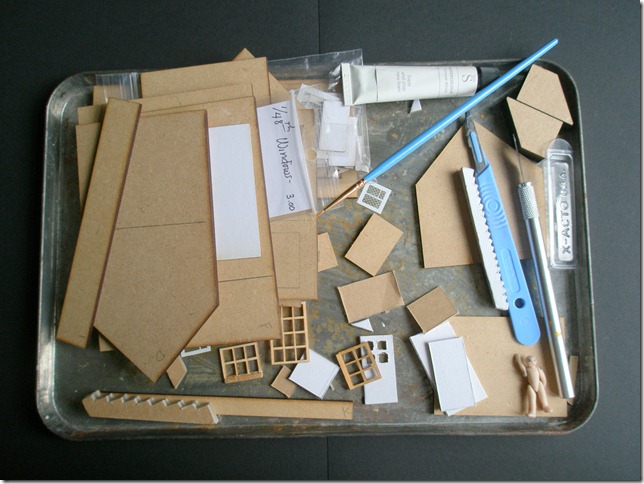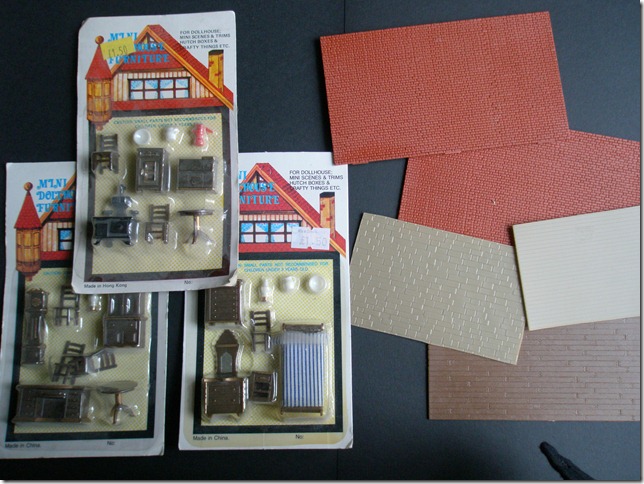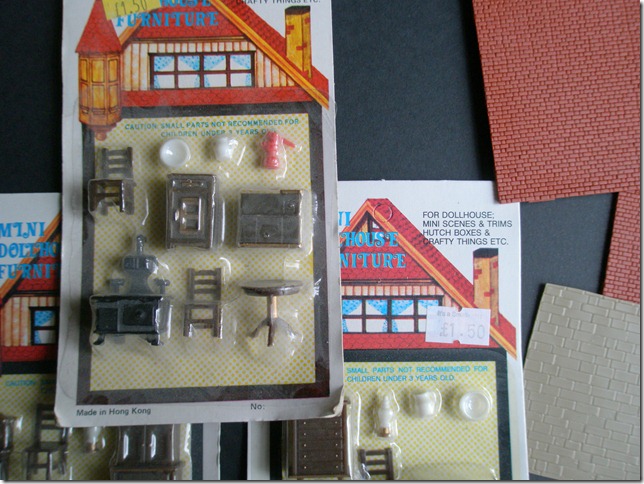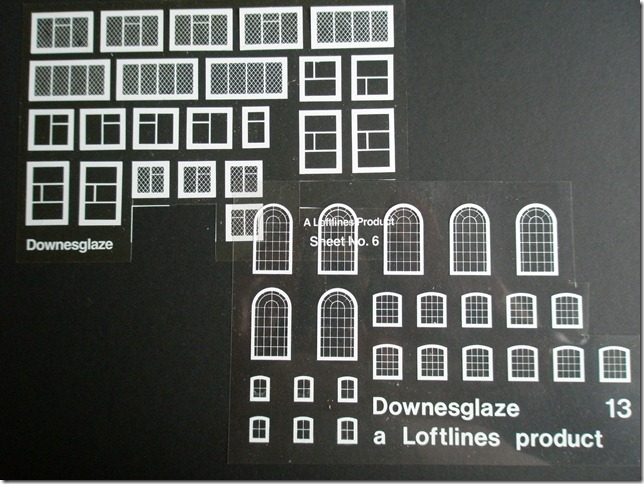Miniature art is an endless hobby, collecting field and fascination. When you have miniaturised one period of history, till you know it so well you could have lived in those times, you can move to another era and learn everyday living all over again. When you have shrunk a geographical location to your table top, you can visit elsewhere. When you are tired of reality, you can visit fantasy and make a house for a witch or a fairy and when you are tired of all those options you can do it all over again in another scale.
Making miniatures in another scale sharpens up your skills considerably; there are many scales to try, each with its own advantages and problems. 12th scale is considered the industry standard; in this a foot, 12 inches in real life, is represented by an inch in the corresponding miniature item. So a six foot man will become a six inch doll, a thirty six foot tall house becomes a three foot tall miniature house and so on.
Before the second world war children’s toy houses made by several manufacturers were commonly available in 16th scale. This works out at just a bit smaller because it’s one sixteenth of reality rather than one twelfth. The doll is now 4 inches tall, the house is two feet three inches tall.
The hobby revived recently in the 1970s, in 12th scale. By the turn of the century into the 21st, 24th scale, called half scale in America, was beginning to emerge. This is half the size of 12th scale or a 24th the size of life. The doll is now 3 inches, the house is 18 inches.
About 14 years ago I tried to make a house in 48th scale, otherwise known as quarter scale, because it’s a quarter of the size of 12th scale (it’s also, as I’m sure you’ve guessed by now, a 48th the size of life.) The doll in 48th is 1.5 inches tall, the house is 9 inches. I had to abandon my attempt because there were insufficient items available to complete and accessorize the house.
There is also 144th scale, for the dolls’ house in your 12th scale dolls’ house and 288th scale for the dolls’ house in your 24th scale house.
And there are as well all the odd scales adapted from other hobbies: there is model railway O gauge which is 43rd scale and assorted military modelling scales. This explains why in the inventories of dolls’ house shops, in the category of 48th you sometimes find Napoleonic swords, crates full of milk churns, filled postbags and other items you might find in a war or on a railway platform. Do not dismiss these out of hand, a visit to a model railway shop can be very productive providing you don’t throw caution to the winds and buy a train set.
Now 48th scale is very possible with many choices of the type of house to build or buy and even specialist retailers of this small scale. New in the links you will find In Some Small Way, Judith Dowden’s sites which feature wonderful houses by a variety of makers, many of them imports from America where there are a number of highly specialised miniaturists producing kits and ready made miniatures. There have not been many makers of porcelain dolls you can play with in this scale. There are available metal (railway) figures, and assorted paper mache figures and polymer clay figures but usually these are static and often quite fragile. After 18 years of practice I am ready to make porcelain dolls with flexible limbs that will be able to sit on the chairs, kneel down to scrub the floors and then lie flat on the beds to have a good night’s sleep. Proper dolls you can play with is my aim and fairly obviously they should be one and a half inches tall if they are a six foot man.
Or should they? In life you get big uns and little uns and so you do in miniature, which is why for eighteen years I’ve made big twelfth scale dolls and little ones and so on in every scale so far. My purpose has always been to assist the miniaturist who turns up at my table desperate to find a doll to fit in an odd size house. This is more difficult to do the smaller you go which is why I am going to make three different 48th scale houses here over the coming months and at the end make dolls that will look good in any of the houses. I will also share hints and tips gathered over a quarter of a century of miniaturising.
I hope you assembled some of the handy items I suggested yesterday, to them I would add a self healing cutting mat unless you want to resurface the dining table afterwards. You also need a steel ruler, because a craft knife will cut the edge off a wooden one and trays. You need at least two trays, which need not be posh, this one is a tatty old toffee tray.
On it, as you can see, I have all the bits. If you put loose kit parts on the table where you’re working they will disappear. They are light and get blown off the table when you put a piece of paper down, or sigh deeply because it’s two in the morning and you just want to get the floor done before you go to bed. A tray, providing you remember to put the piece back there after the trial fitting, will save endless hours on your hands and knees, searching.
You need another tray to put the partially finished building on, to prevent it being squashed when you put it on a chair because it’s the only surface left to work on, which will happen a lot sooner than you think. I’d also recommend a biscuit tin lid lined with waxed paper (the backing off clear sticky backed plastic for covering books, with the printed squares is ideal) and a couple of magnets (fridge will do) as a gluing jig for furniture assembly.
These three trays will save so many arguments if you do not live alone, because you can clear the dining table to dine upon (who knew?) in a flash, without damaging or losing work in progress and keep the family sweet. This is a good plan because once you get into the creation of this little world you may not care about anything else. You may wish to invest in drip dry clothes for all before you begin, only a dolt or a doormat would iron when they could be miniaturising. I taught my husband to iron his own clothes, which he does, one at a time as he needs them. This took 25 years, drip dry is a lot quicker.
Other items worth looking out for are model railway cladding of various kinds: brick, stone, pavements and those plastic sets of 48thish furniture which can be painted, refinished and fill spaces in houses until you upgrade to something swisher.
Here’s a closer look at the furniture, mine’s a bit dusty having lived in a box for 14 years.
Model railway screen printed windows are also a possibility because they come in many architectural types, look for 4mm or O gauge.
I’m going to begin with a Petite properties basic house made by Bea Broadwood. You can find Petite Properties in the links, a click will take you to the site which has just been updated to include all the new 48th scale houses. Prices start at £9-99. I’m using an Orchard House basic kit, which cost £19-99. There are also books available, written by Bea, that explain all the possibilities and the finishes. I’m not using one of those, I have the instructions that come with the kit and I will be kitbashing it substantially. Kitbashing, is not as you may suppose, the act of taking the unfinished house outside on its tray and beating it to smithereens with a cricket bat whilst shouting ‘Flipping miniatures! No dinner, no ironing, no sleep!’ Rather it is the altering of the kit as you build, to create something slightly variant from the original or utterly unrecognisable.
I shall also be kitbashing one of the new Dijon kit houses. There are five to choose from on the website at £6-21 each; you can find them by clicking on 48th houses underlined on the home page. I’ll also be trying the flat pack furniture kit. Dijon is now in the links.
And I shall finally be getting out my unfinished house from all those years ago. This is not a dolls’ house at all, it’s actually a set of shelves, possibly a spice rack, that came unfinished from a craft shop, which I shall be turning into the type of house that was known as a baby house in the 18th century.
So there is plenty of choice at the lower end of the property market, which is a good place to begin to see if you like 48th scale. You could also look for a suitable box to turn into a room or a house. Perhaps one of those wooden gift boxes you get at Christmas with cheese or soap (or that special kind of Christmas cheese that tastes like soap.) There are also long narrow wooden boxes that originally housed a bottle of expensive wine and practically anything else that came ‘gift boxed’. It doesn’t have to be a wooden box; a strong board box of the type that comes stocked with nice letter writing paper, might suffice. In 48th a room that in life is 12 feet high, which would be a typical Victorian house, would be miniaturised as three inches. That, however, is quite a high room, modern houses have 8 feet ceilings which would be 2 inches. So look for a box that can be subdivided into rooms between 2 and three inches tall. The width can be anything depending on whether it’s to be a toilet or a ballroom. The depth should not be further than you can get your hand or tweezers into, you have to be able to place the miniatures inside if you wish to play with it. It is possible to have a house that is two rooms deep but to do so you have to finish the room at the back and stick everything down so you can only see the room through the window, or have extra openings on other sides. Most basic houses are one room deep to avoid this problem, I’ll try to illustrate the possibilities as I go so you can look and decide. One final word, before we begin building, about the openings. American houses in all scales tend to have the opening on the back elevation, frequently always open. This arrangement provides the possibilities of more complex architecture on the front of the building including for example, fragile miniature fretwork that could be damaged on an opening wall. British houses have been traditionally front opening with a box back. These are handy in larger scales because you can stand them against a wall without obscuring the detail, they’re also less attracting of dust, having a closing front. In 48th the entire house can stand in landscaped grounds and still fit in a bookcase or on a windowsill, so the choice of openings is up to you, though the shelf house is designed to be hung on the wall, and I’ll make it to do so.
Whilst all these kit houses are made of different types of wood, I shall be making extra walls and alterations with assorted types of board. Artists’ mounting board is useful, though not as strong as one would wish. Most of my structural changes I’ll be making with artists’ acrylic painting board, I bought a pack of five 9 inch x 6inch boards in a sale for 99p. These are quite a bit stiffer than mounting board, being 2mm thick. They are finished on one side with a white canvas texture, and brown board on the reverse. They are a good size to work with in small scale. If you buy a whole mounting board you may prefer to cut it down to A4 size or thereabouts to work on, so it doesn’t fight back so much. Picture framing shops often have offcuts of mounting board which they are willing to sell cheaply (they’re all the middles left over when they have cut a picture frame out.) You could also look at packaging for possibilities. Strong shoe boxes, for example the kind heavy boots come in, are a possibility. Corrugated board, if it is very closely made and unlikely to delaminate when cut, is another. If you can cut the board with your strongest scissors or your craft knife but not fold it in half with your fingers, it’s worth trying. It doesn’t need to be as thick as the original wooden house sides you’re kitbashing because layers are going to have enormous structural advantages, as I shall demonstrate next time. It does need to be strong enough to paint or glue without disintegrating, and whilst light colours are easier to mark for cutting, if it can be painted, the colour is not important. Neither is a printed notice saying ‘Another pair of Expensivo ladies boots’ or ‘Portalike, quaffable fortified wine for the indoor drunk’ or even ‘herring scented cat litter, quarter ton.’
Next time! Next Time! I hear you cry, I know, wasn’t that a fast two thousand words? As I write it’s quarter past one. I must get some sleep because I want to get up early, I’m halfway through a wall and I want to tread my stairs tomorrow. Before next time, which may be sooner than Wednesday, (keep looking,) you may wish to visit the suggested sites and go house shopping, or look for a box or visit your local art shop and have a rummage through the sale bin. While you’re out you may need to purchase some ready meals, because there won’t be time for cooking and nowhere to eat it anyway.
Starting on a new little house is an adventure in time and space, if you have the time I’ll always make room for you here.
********************************************************
JaneLaverick.com- small but nicely made.




